The construction industry is booming.
In fact, worldwide industry spending is expected to reach $24 trillion by 2025.

While this means there are more and more opportunities for your construction company to acquire new customers, that also implies more competition.
Unless you want to get left in the dust and beat by other local businesses, your marketing needs to be sharper than a butcher’s knife.
But you’re in luck… because today I’ll be covering several construction marketing ideas you can start using to grow rapidly.
These will help you acquire more clients, increase market share, and explode brand awareness to new heights.
Let’s dive in!
Use content to generate authority and organic clients
Does your construction business produce content on a regular basis such as articles, videos, or podcasts?
If not, you need to start immediately.
But don’t listen to me. Listen to the data…
Korte Company, one of the largest design-builders in the United States, was having trouble converting website users into leads.
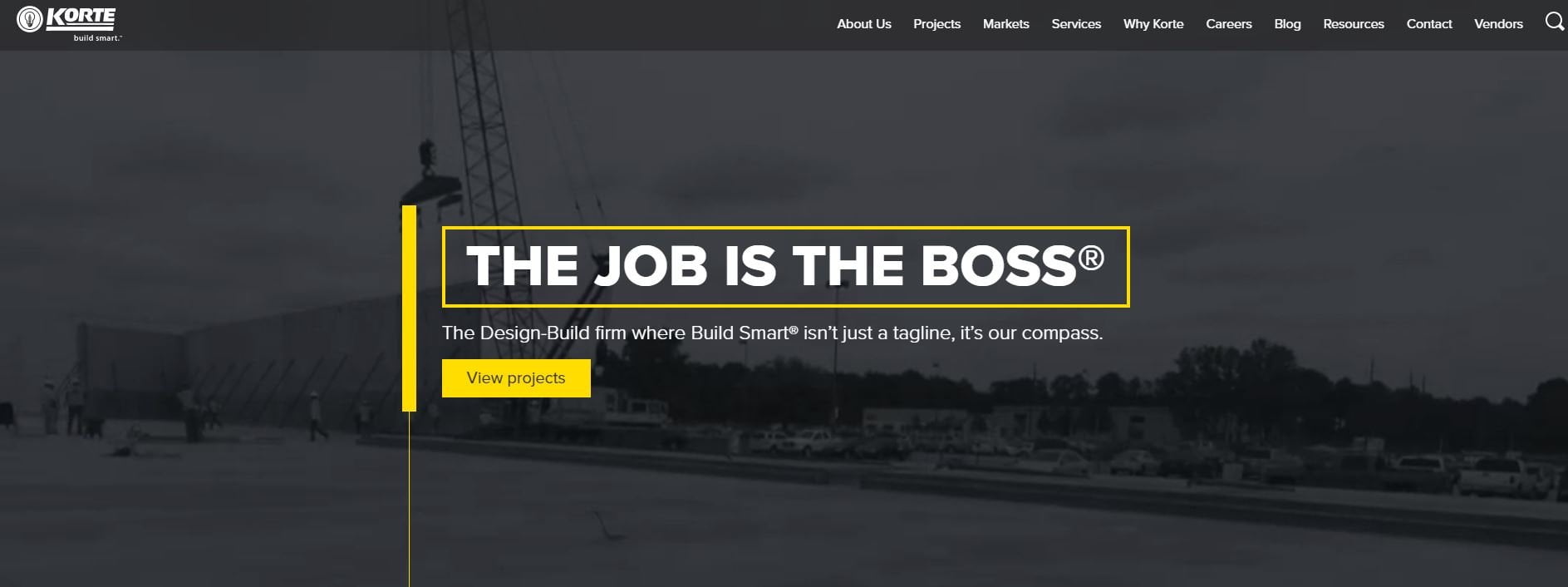
They reached out to a digital agency like myself and had them create content that would provide free value to users while collecting leads.
The result? A 650% increase in monthly website contacts!
Imagine the new amount of clients you could generate with numbers like that.
Follow the steps below if you wish to experience results like Korte did.
Step 1: Choose a single channel at first
You don’t want to spread yourself too thin when you begin creating content.
That’s why I recommend you choose one channel and master that before moving onto another.
I believe that blogging is the best foundation for any business because it generates traffic to your website, builds backlinks, and it has a low barrier to entry.
Furthermore, 81% of businesses agree that their blog is critical to success.
If you have a website and keyboard, you can begin blogging!
Those who decide to go the route of blogging should also keep the following tips in consideration:
- Word count: Long form content ranks higher than short content and provides more value to users. Don’t write anything less than 1,000 words, but try to aim for 2,000 and beyond if possible. Hiring a content writer like myself can speed up this process.
- Actionable: Content needs to teach the reader something and not leave them wondering what to do next. Provide as many tools, resources, and steps to ensure they make progress towards their goal.
- Tone: A casual and friendly tone works well for any industry. It’s simpler to read and makes the user feel like they’re speaking with an acquaintance.
This brings me to my next point.
Step 2: Produce content on a set schedule
Building a loyal readership or following takes times and consistency.
This is why it’s extremely important that you create a set schedule for publishing content.
The more content you publish, the more traffic you can generate and the faster you’ll get towards your lead generation goals.
You can start producing content a few times per week and gradually ramp up the volume if you wish.
My philosophy with inbound marketing was that I would publish more content as the results increased, which I’ve followed to this day.
However, it’s quality over quantity.
Don’t release content for the heck of it. Rather, only offer content that would genuinely improve the lives of readers and blow their minds.
It’s been proven that once you hit the 52 blog post mark that traffic tends to increase by 77%. Patience is the key to success with this method.
Step 3: Promote the heck out of content
While Google and other search engines will do a lot of the heavy lifting to get you seen by more people, you should still promote content for immediate traction.
Doing so will allow you to generate traffic on the spot and build momentum.
Additionally, social links and shares as a result of promoting content are seen as ranking signals.
This means that if you regularly promote content on social networks, it can boost your positions on Google!
Besides social media, you should also be emailing out new content to subscribers. If you don’t have an email list, I’ll be teaching how to build one later in this article.
It’s also effective to reach out to other websites in your industry and share your content with them.
Ask if they’d be kind enough to share your content on social media or link to it, and do the same for them beforehand to offer value.
Use social media to show off new properties and projects
Sure, social media is great for connecting with customers and promoting content, but it’s also amazing to show off the new projects you’re doing.
This helps potential customers see what you’re capable of offering them.
Look how this construction company uses Twitter to display their new projects and technology:

They receive good engagement which can easily convert into leads.
This is especially effective if you’re in the home building space, as well.
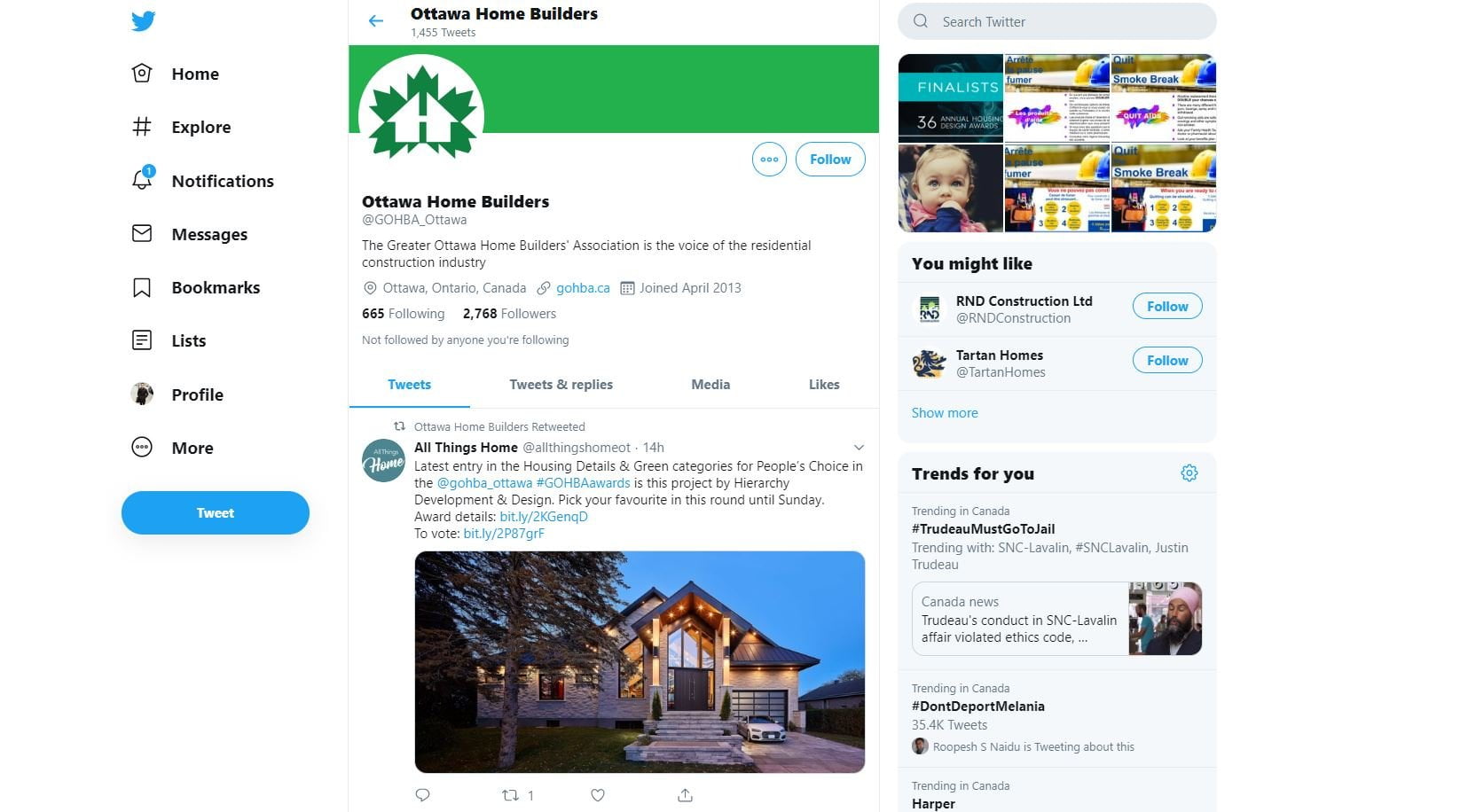
You can see that this company, Ottawa Home Builders, shares and retweets properties they’ve helped develop.
Potential customers that are following them are then exposed to homes, which are the product, and could potentially become a paying client.
Collect an email list of subscribers
Email marketing is old. I mean really old.
It was officially invented back in 1971 by Ray Tomlinson, yet remains as one of the most effective ways to reach customers.

Collecting an email list will also allow you to make your own audience.
Joe Pulizzi, the founder of Content Marketing Institute, talks about this in one his live presentations:
Joe mentions that creating your own audience is key in today’s business world because we don’t own any platform we’re on.
That means you could get the boot and there’s nothing you can do about it.
Similarly, platforms like Facebook could reduce organic reach and suddenly you can’t reach the millions of followers you built.
Years of hard work is instantly lost and you can’t bring it elsewhere, unless you take advantage of email marketing, of course.
Here’s how to start building an email list and land more construction clients with it…
Step 1: Choose an email marketing service provider
Mailchimp, Mailjet, Aweber, the list goes on.
There is no shortage of email marketing automation tools you can use these days.
That’s why I suggest you browse through all of the major ones like:
- OptionMonster
- Mailchimp
- Mailjet
- Aweber
- Sendgrid
- ConstantContact
Try out demos, read their knowledge databases, and compare pricing plans.
Every company has different needs so I don’t want to tell you to choose a specific one because there may be a better option you miss.
I will say that most of the major email marketing tools offer relatively the same features, though.
The differences are smaller qualities, pricing, UI, etc. That’s why the best thing you can do is take advantage of free accounts and demos to see which one is best for you.
This brings us to the next step.
Step 2: Create opt-in forms and a lead magnet
After you’ve chosen an email marketing tool, you now need to create an opt-in form for subscribers to use.
Opt-in forms come in all shapes and sizes.
There are popups, footer forms, sidebar forms, and more depending on the exact tool you use.
However, where you place the form can make a huge impact on conversion rates.
For example, Growth Rock tested a sidebar form on 100,000 monthly visitors and it only had a 0.3-0.6% conversion rate.

Blah.
This is why they recommend you consider popups, content upgrades, homepage gates, and hero units.
All of these are statistically proven to have much better conversion rates.
While it might not be the most drastic jump depending on your traffic, it could be all the difference for landing that new six-figure client.
And once you publish the opt-in form, leads will start pouring in, right?
Not so fast.
You won’t be getting many subscribers if you don’t offer free value in the form of a lead magnet.
As you could guess by the name, lead magnets are resources that act as a magnet to attract leads.
Think e-books, whitepapers, case studies, and cheat sheets.
Look how Salesforce offers e-books you can download but you must enter in your information first:

Take notes!
Step 3: Use the 80/20 rule for newsletters
You did it. You finally built an epic email list of subscribers. What’s next?
Sending out newsletters.
But hear me out, please.
Someone was kind enough to give you their personal information, so don’t exploit that by overselling your services and invading their privacy.
Instead, use the 80/20 rule also known as Pareto’s principle.
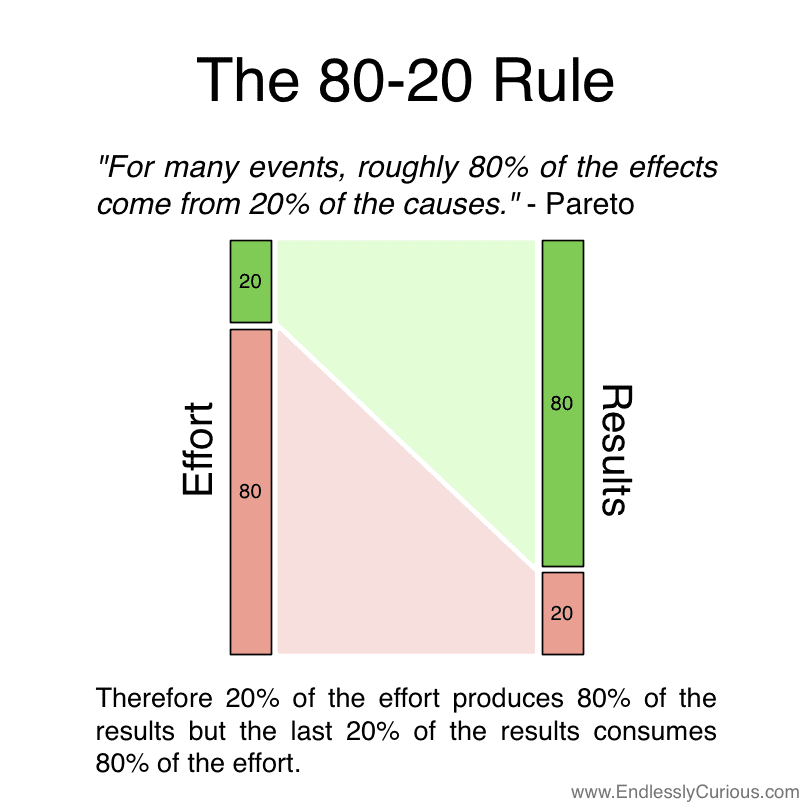
In the case of email marketing, this means that 80% of your newsletters should be blog posts, updates, and direct value.
The remaining 20% can be self-serving and promotional.
The reality is that nobody wants to constantly open their inbox to ads.
If you spam them too much, they’ll opt out faster than a jet!
Attend as many tradeshows as possible
Nothing beats shaking hands and face-to-face contact.
84% of people prefer meeting in-person, so don’t neglect it just because everything is digital these days.
No matter where you live there will be tradeshows, networking events, and conferences you can attend.
These will help you meet potential partners and clients.
I recommend searching for local events via Google with keywords like:
- “Construction networking events”
- “Construction conference”
- “Land developer conference”
- Etc
You will have no shortage of events to choose from as you can see:
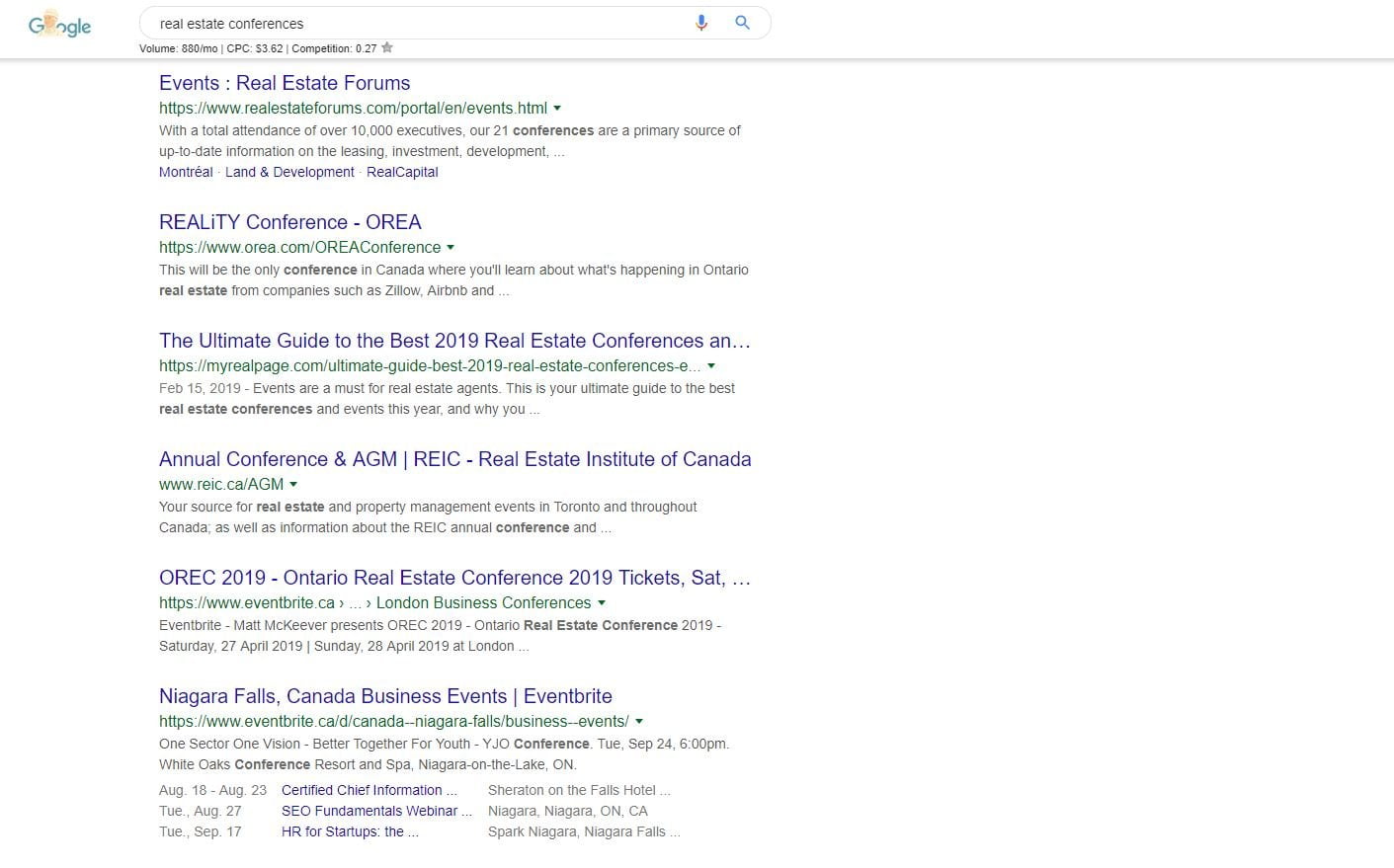
Finding the events isn’t the hard part, though. It’s making the most of them.
I like to attend networking events on a regular basis, and it’s all too easy to sit around with a drink doing nothing.
You need to proactive.
That means striking up conversations with people, asking or giving business cards, and following up.
It’s also great if you can become a regular at certain events because you’ll create a positive reputation for yourself.
Here are some other tips I have for maximizing conferences:
- Dress the part: Show up in business casual attire or a suit. First impressions are huge at networking events. You want to appear professional and give your company a good image.
- Bring cards: Have business cards handy, but don’t be that guy running around shoving them in people’s faces. Give them out if they’re asked for but avoid coming off as a snake oil salesman.
- Be a social authority: These events can be awkward. That’s why I recommend you help introduce people to others because it helps you gain status at the event and looked at in a better way.
- Follow up: Email or call those you met at events, especially anyone that could be of interest for a partnership or project.
Optimize your website for search engines
70-80% of users ignore paid ads and only focus on organic results. It goes without saying that SEO is crucial for modern day success in business.
Nonetheless, so many construction companies neglect their SEO and it shows.
They don’t rank on the first page for good keywords, their website traffic stinks, and the site itself is practically a paperweight.
Sound familiar?
Don’t worry because you can be experiencing more traffic and leads via search engines with some quick tweaks.
Construction SEO is a lot simpler than you might think, too. Try out the following methods to see the results for yourself
Get up to speed, literally
Page speed is a huge determining factor in how you will rank on Google.
This is because if your page speed is slower than a turtle, more users will bounce signaling to search engines your website isn’t useful.
A faster website makes users happier and allows Google’s bots to scan your website quicker.
It’s win-win!
You can check out the speed up your website using a tool like this one. Begin by entering the URL of your website and clicking the “Try Now” button.
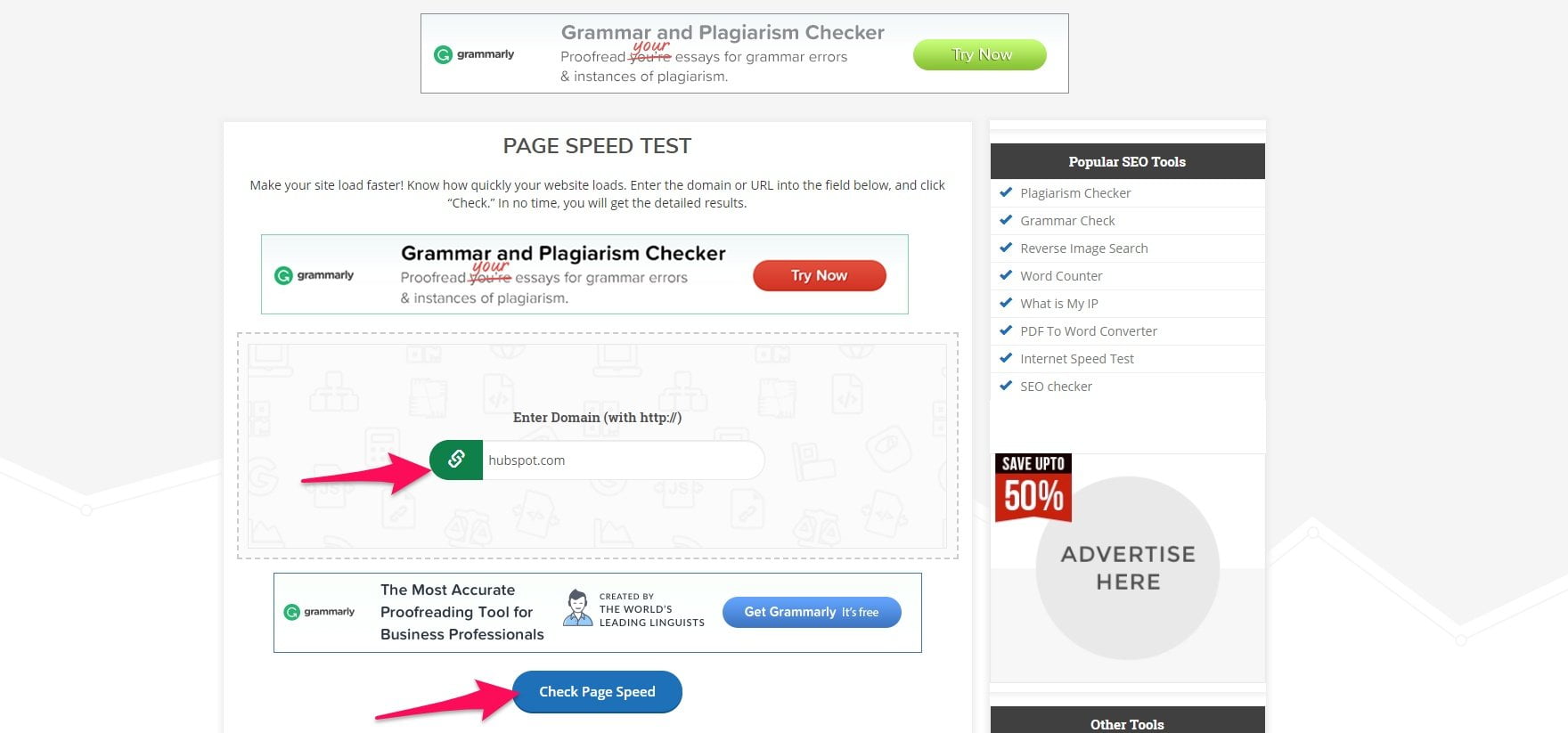
The following page will display information about your website and why it was rated the score it was given.
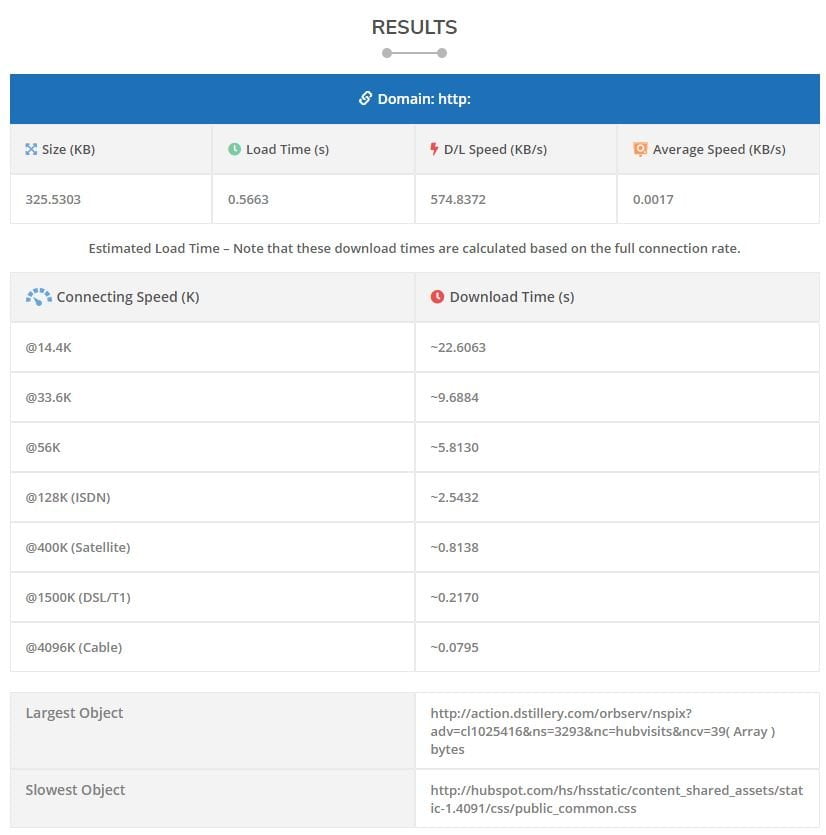
This information can then be used to speed up any lagging parts of your website.
You may have to hand this information off to your IT department or marketing specialist if you’re not the most tech-savvy individual.
They are often quick fixes that make drastic improvements, anyways 🙂
Focus our website around construction-related keywords
Keywords are phrases which users type into Google to find a specific resource.
You can strategically use keywords to be placed right in front of your target audience.
Try using a tool like WordStream. You can enter a search term in the keyword field, choose an industry, set a location, and hit the search button.
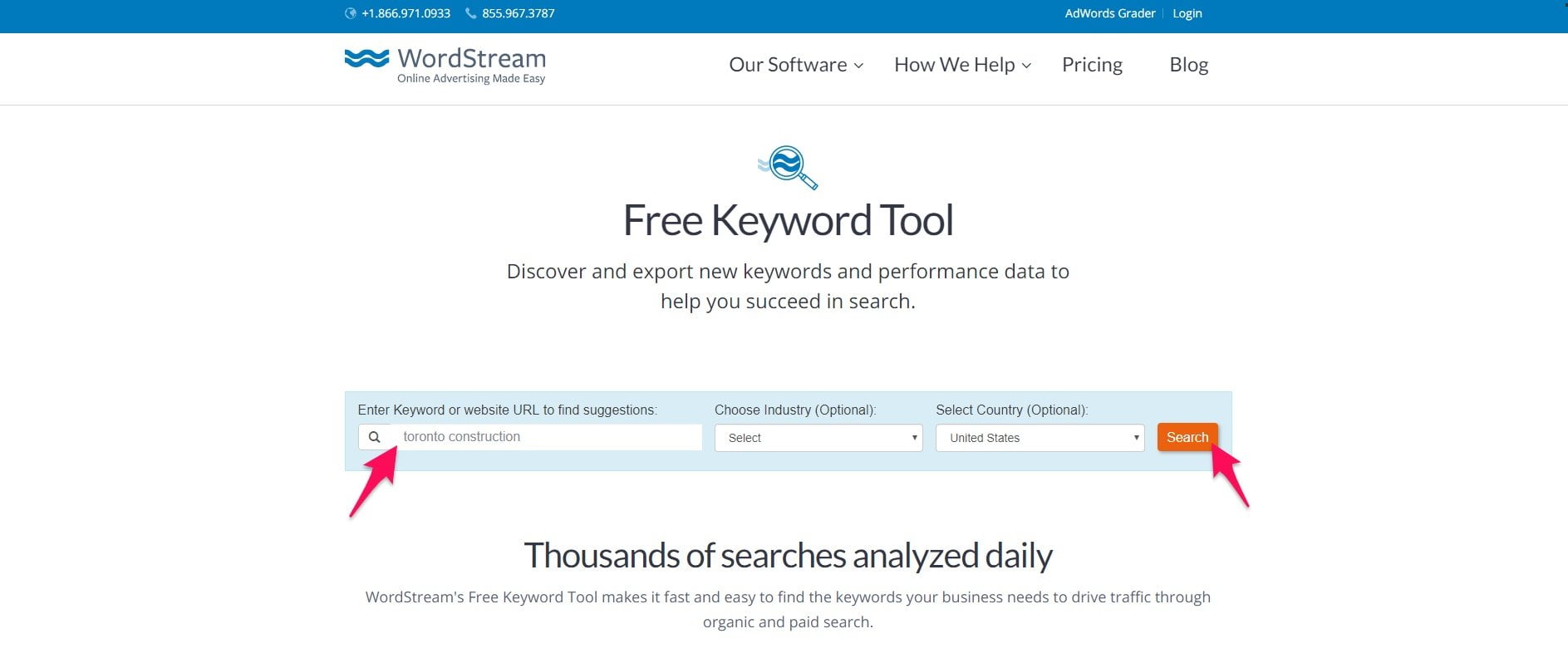
This will bring you to the following page where WordStream displays keyword suggestions and their metrics.

The free version blurs out most of the data which is why I suggest you enter any keywords that seem of interest into Google and analyze the top results for:
- Word count
- Authority
- Content quality
- Etc
If the tops results for any chosen keyword look on par to your business, you should be able to rank out-rank them.
However, you’re probably thinking “Where the heck do I use these keywords, anyway?” and here’s your answer:
- Title tags, article headlines, and URLs of web pages should include a keyword. This helps both users and search engines understand what a page is about.
- Keywords placed in meta descriptions become bold when a user searches for them, helping to increase the click-through rate of your search engine listing.
- Place keywords within the body of pages a couple of times and use variations of them.
- The alt text and file names of media can be optimized to include keywords as Google scans these resources, as well.
- Header tags break up content and also signal to Google the major points that make up web pages. Add keywords into these H1, H2, and H3 tags.
Claim local business citations
Backlinks are necessary if you want to outrank other construction companies in search engines.
These are links which point to your website from another, telling Google that your site is important.
Think of it as a voting system and having more votes makes you the cool kid on the block.
While you can launch massive backlink building campaigns through guest posting and broken backlink building, which I’ve touched on before, you should keep it simple by claiming local citations.
These are directories and websites you can list your business under, helping you generate local leads while also improving SEO.
Here’s a list of citations you can claim today to instantly boost your web presence and search engine power:
There are dozens more you can take advantage of, some of which are based on your location or industry. So, gradually claim as many listings as possible.
Final thoughts on creating a construction marketing plan
The construction industry is easily one of the most lucrative markets to start a business.
I’ve seen people make six to seven-figure companies practically overnight.
However, it doesn’t happen easily or through luck.
You need the right marketing strategies to acquire high paying clients and not get run over by competitors.
Apply the main takeaways below to achieve just that.
- Use content marketing to increase the authority of your brand, acquire clients organically, and boost search engine presence. Choose one channel and publish content on a regular basis. Promote it via social media, email, and outreach.
- Take advantage of social networks for displaying your latest projects to show leads what your business is capable of providing.
- Begin growing an email list through opt-in forms and lead magnets. Send newsletters that provide value 80% of the time and use the remaining 20% to send promotional material.
- Optimize your website for search engines to generate more organic traffic and leads. You can do so by increasing page speed, keyword research, and building links.














